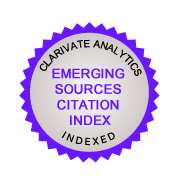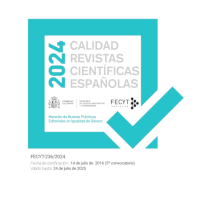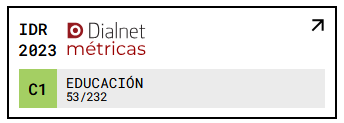Reliability and sources of validity evidences for a instrument assessing the quality of concept maps
DOI:
https://doi.org/10.18172/con.3065Keywords:
Concept map, assessment, intervention, instrumentAbstract
Several authors have noticed the interest and relevance of concept mapping as a tool for promoting meaningful learning. However, the current literature highlights the lack of procedures for the assessment of concept mapping using objective criteria, as well as the complexity of the existing ones. The aim of this study was to develop an instrument for assessing concept maps through a rubric format. It is expected to provide the students with a tool that allows, through precise indicators, the assessment of the quality of their and others’ performance. A rubric that includes the most widely accepted criteria in the literature is presented and examined. Two pilot studies with a group of pre-service teacher students each one (n = 31 and n = 18, respectively) were conducted through a four hours training program. The results indicated that the designed instrument shows good indicators of interrater reliability and discriminant validity. It is then concluded that the designed instrument shows adequate psychometric properties. The instrument allows both the use of objective criteria in the assessment of concept maps, and the comparison between different executions.Downloads
References
Ausubel, D. P., Novak, J. D. y Hanesian, H. (l987). Psicología educativa. Un punto de vista cognoscitivo. México: Trillas.
Cañas, A. J., Novak, J., Miller, N. L., Collado, C., Rodríguez, M., Concepción, M., Santana, C. y Peña, L. (2006). Confiabilidad de una taxonomía topológica para mapas conceptuales. En Second International Conference on Concept Mapping: September 5-8 2006. San José, Costa Rica: Universidad de Costa Rica.
Domínguez-Marrufo, L. S. (2010). Rúbrica y Puntaje del Mapa Conceptual. Una propuesta para la evaluación de mapas conceptuales en la educación Superior. (Tesis de maestría no publicada). Universidad Autónoma del Estado de Morelos, México.
Domínguez-Marrufo, L. S., Sánchez-Valenzuela, M. M. y Aguilar-Tamayo, M. F. (2010). Rúbrica con sistema de puntaje para evaluar mapas conceptuales de lectura de comprensión. En J. Sánchez, A. J. Cañas y J. D. Novak (Eds.), Concept maps: Making learning meaningful (pp. 210-213). Chile: Lom Ediciones.
González, F. M. (1997). Diagnosis of Spanish Primary School Students’ Common Alternative Science Conceptions. School, Science and Mathematics, 2, 68-74.
González, F. M. e Iraizoz, N. (1995). Errores Conceptuales en Alumnos de Enseñanza Primaria: Implicaciones Educativas. Estudios de Psicología y Pedagogía, 7, 67-116.
González, F. M., Moron, C. y Novak, J. D. (2001). Errores conceptuales. Diagnosis, tratamiento y reflexiones. Pamplona: Eunate.
Iraizoz, N. y González, F. (2003). El mapa conceptual: un instrumento apropiado para comprender textos expositivos. Pamplona: Blitz.
Luque, A., Molina, A. y Ontoria, A. (2003). Los mapas conceptuales, una técnica para mejorar las capacidades cognitivas y sociopersonales. Revista de Ciencias de la Educación, 194, 207-224.
Miller, N. L. y Cañas, A. J. (2008a). A semantic scoring rubric for concept maps: design and reliability. En Third International Conference on Concept Mapping, sept. 22-25, 2008. Tallinn, Estonia: Tallinn University.
Miller, N. L. y Cañas, A. J. (2008b). Effect of the nature of the focus question on presence of dynamic propositions in a concept map. En Third International Conference on Concept Mapping, sept. 22-25, 2008. Tallinn, Estonia: Tallinn University.
Novak, J. D. (1998). Conocimiento y aprendizaje: Los mapas conceptuales como herramientas facilitadoras para escuelas y empresas. Madrid: Alianza.
Novak, J. D. y Gowin, D. B. (1988). Aprendiendo a aprender. Barcelona: Martínez Roca.
Novak, J. D. y Musonda, D. (1991). A twelve-year longitudinal study of science concept learning. American Educational Research Journal, 28, 117-153.
Ontoria, A. (1992). Mapas conceptuales una técnica para aprender. España: Narcea.
Pascual, M. T. y Pérez-Albéniz, A. (2006). Enseñar a pensar en el aula universitaria. Una experiencia en las aulas de maestro de la Universidad de La Rioja. Contextos Educativos, 13, 141-154. DOI: http://doi.org/10.18172/con.631.
Pérez-Albéniz, A., Lucas-Molina, B., Solbes-Canales, I., Calderón, S., y Martín- Seoane, G. (2016). Los mapas conceptuales como estrategia de aprendizaje en la enseñanza universitaria. Innovación Educativa, 26, 233-243. DOI: http://doi. org/10.15304/ie.26.3449.
Reyes, M. (2005). Uso de los mapas conceptuales en química. Mérida: Escuela Venezolana de Enseñanza en Química.
Siegel, S. y Castellan, N. J. (1988). Nonparametric statistics for the behavioral sciences. New York: McGraw-Hill.
Statistical Package for the Social Sciences (2006). SPSS Base 15.0 User’s Guide. Chicago, IL: SPSS Inc.
Downloads
Published
How to Cite
Issue
Section
License
The authors retain copyright of articles and authorize Contextos Educativos. Revista de Educación the first publication. They are free to share and redistribute the article without obtaining permission from the publisher as long as they give appropriate credit to the editor and the journal.
Self-archiving is allowed too. In fact, it is recommendable to deposit a PDF version of the paper in academic and/or institutional repositories.












